






According to the National Bureau of Statistics (NBS), in October 2025, the national consumer price index (CPI) rose 0.2% YoY. Specifically, prices in urban areas increased by 0.3%, while those in rural areas decreased by 0.2%; food prices fell by 2.9%, while non-food prices rose by 0.9%; prices of consumer goods dropped by 0.2%, while prices of services increased by 0.8%. On average from January to October, the national CPI decreased by 0.1% compared to the same period last year.
In October 2025, the national producer price index (PPI) for industrial products fell by 2.1% YoY, with the rate of decline narrowing by 0.2 percentage points from the previous month; on a monthly basis, it shifted from being flat in the previous month to an increase of 0.1% MoM. The purchasing prices for industrial producers dropped by 2.7% YoY, with the rate of decline narrowing by 0.4 percentage points from the previous month; on a monthly basis, they rose by 0.1% MoM, the same rate of increase as the previous month. On average from January to October, the PPI decreased by 2.7% compared to the same period last year, while the purchasing prices for industrial producers fell by 3.2%.
Dong Lijuan, Chief Statistician of the Urban Department of the NBS, interpreted the CPI and PPI data for October 2025.
Consumer Prices Rose 0.2% YoY in October 2025
In October 2025, the national consumer price index (CPI) increased by 0.2% YoY. Specifically, prices in urban areas rose by 0.3%, while those in rural areas fell by 0.2%; food prices decreased by 2.9%, while non-food prices increased by 0.9%; prices of consumer goods declined by 0.2%, while prices of services rose by 0.8%. On average from January to October, the national CPI decreased by 0.1% compared to the same period last year.
In October, the national CPI increased by 0.2% MoM. Specifically, prices in urban areas rose by 0.2%, while those in rural areas increased by 0.1%; food prices went up by 0.3%, while non-food prices rose by 0.2%; prices of consumer goods increased by 0.2%, and prices of services rose by 0.2%.
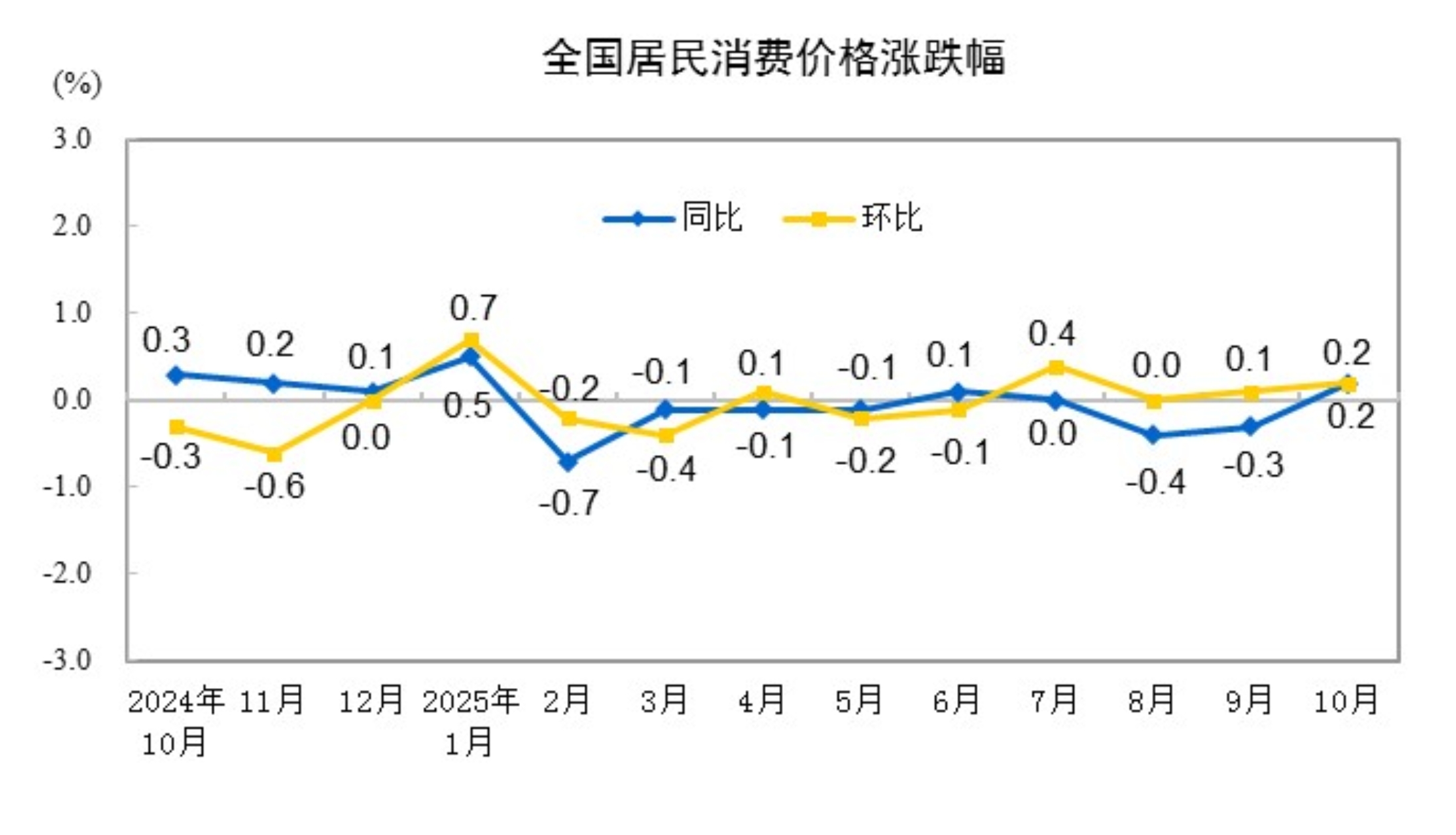
I. Year-on-Year Changes in Prices of Various Goods and Services
In October, prices of food, tobacco, and alcohol decreased by 1.6% YoY, dragging down the CPI by approximately 0.46 percentage points. Within the food category, egg prices fell by 11.6%, pulling down the CPI by about 0.08 percentage points; prices of livestock meat decreased by 7.4%, dragging down the CPI by approximately 0.23 percentage points, among which pork prices dropped by 16.0%, contributing to a 0.23 percentage point decline in the CPI; prices of fresh vegetables fell by 7.3%, pulling down the CPI by about 0.18 percentage points; prices of fresh fruit decreased by 2.0%, dragging down the CPI by approximately 0.04 percentage points; grain prices declined by 0.7%, contributing to a 0.01 percentage point decrease in the CPI; prices of aquatic products rose by 2.0%, pushing up the CPI by about 0.04 percentage points.
Among the other seven major categories, six experienced price increases YoY, while one decreased. Specifically, prices for other articles and services, household articles and services, and clothing rose by 12.8%, 1.9%, and 1.7%, respectively; prices for health care, education, culture and recreation, and housing increased by 1.4%, 0.9%, and 0.1%, respectively; while prices for transportation and communication fell by 1.5%.
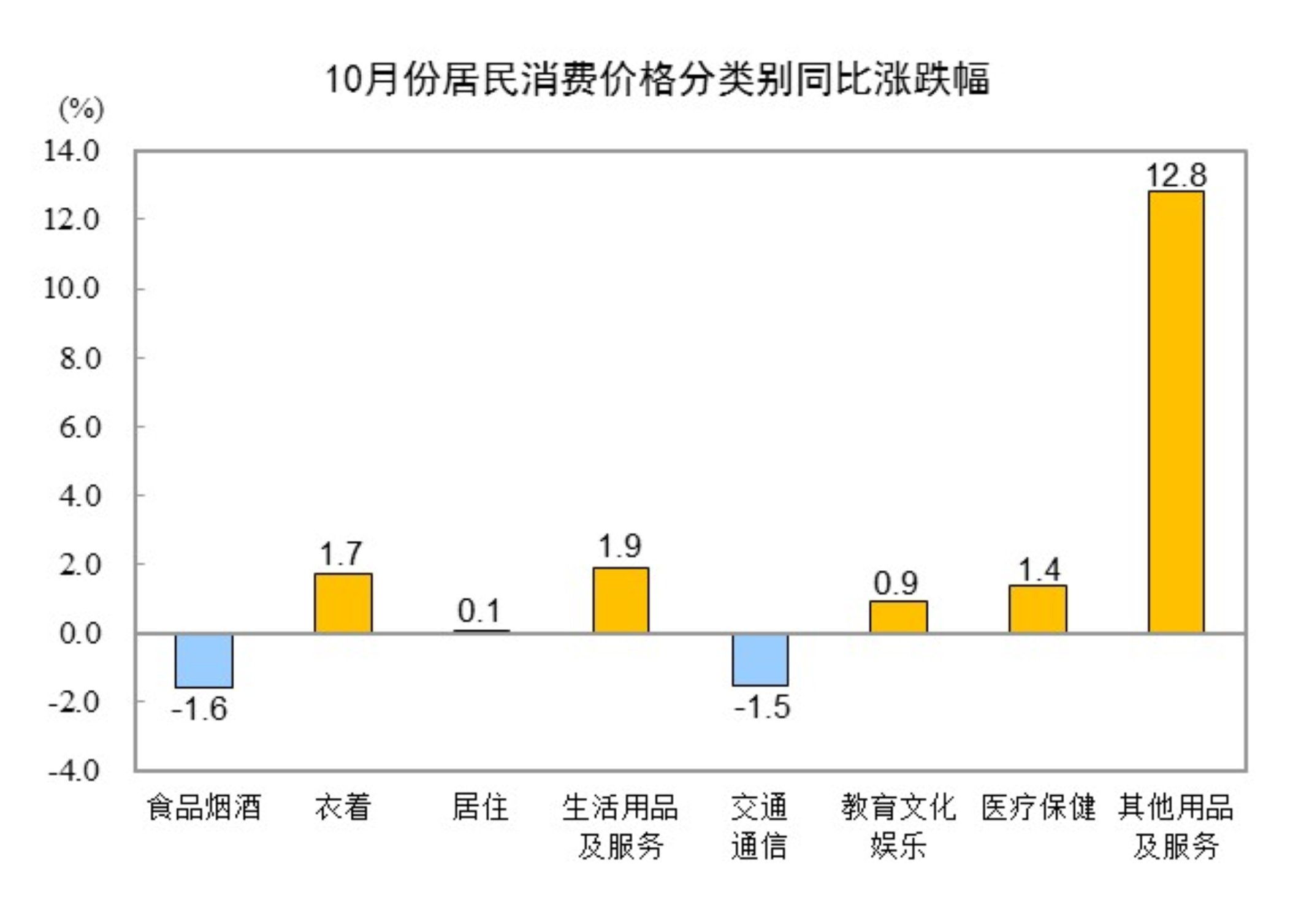
II. Month-over-Month Changes in Prices of Various Goods and Services
In October, prices for food, tobacco, and alcohol increased by 0.2% MoM, contributing approximately 0.07 percentage points to the rise in the CPI. Within the food category, prices for fresh vegetables rose by 4.3%, contributing about 0.09 percentage points to the CPI increase; prices for fresh fruit increased by 1.2%, contributing about 0.03 percentage points; prices for eggs fell by 1.7%, dragging down the CPI by about 0.01 percentage points; prices for livestock meat decreased by 0.9%, contributing about 0.03 percentage points to the CPI decline, among which pork prices dropped by 2.5%, contributing about 0.03 percentage points to the CPI decrease; prices for aquatic products fell by 0.9%, contributing about 0.02 percentage points to the CPI decline.
Among the other seven major categories, prices for three increased, one remained flat, and three decreased on a MoM basis. Specifically, prices for other articles and services, education, culture and recreation, and health care rose by 3.8%, 0.3%, and 0.3%, respectively; clothing prices remained unchanged; while prices for household articles and services, transportation and communication, and housing fell by 0.2%, 0.2%, and 0.1%, respectively.

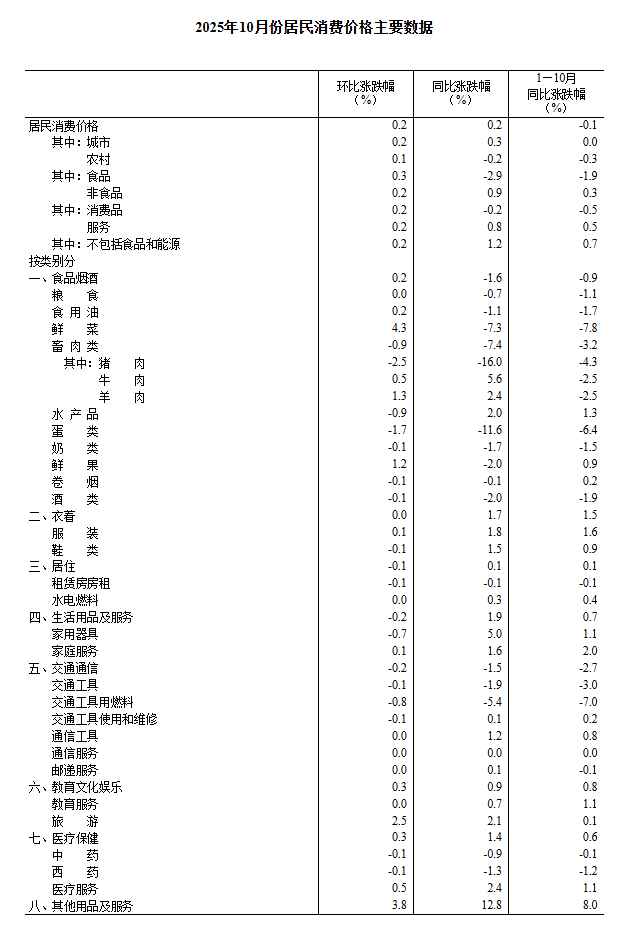
In October 2025, the YoY Decline in Industrial Producer Ex-Factory Prices Continued to Narrow, While MoM Prices Shifted from Flat to an Increase
In October 2025, the ex-factory prices of industrial producers nationwide decreased by 2.1% YoY, with the decline narrowing by 0.2 percentage points compared to the previous month; on a MoM basis, prices shifted from being flat in the previous month to an increase of 0.1%. The purchasing prices for industrial producers fell by 2.7% YoY, with the decline narrowing by 0.4 percentage points from the previous month; MoM, they increased by 0.1%, with the rate of increase being the same as the previous month. On average from January to October, the ex-factory prices of industrial producers decreased by 2.7% compared to the same period last year, while the purchasing prices fell by 3.2%.


I. YoY Changes in Industrial Producer Prices
In October, within the ex-factory prices of industrial producers, the price of means of production decreased by 2.4%, contributing to a decline of approximately 1.77 percentage points in the overall ex-factory price index. Among these, prices for mining and quarrying fell by 7.8%, prices for raw materials decreased by 2.5%, and prices for processing industries dropped by 1.9%. The price of means of subsistence fell by 1.4%, contributing to a decline of approximately 0.36 percentage points in the overall ex-factory price index. Among these, food prices decreased by 1.6%, clothing prices fell by 0.3%, prices for general consumer goods increased by 1.0%, and prices for durable consumer goods dropped by 3.2%.
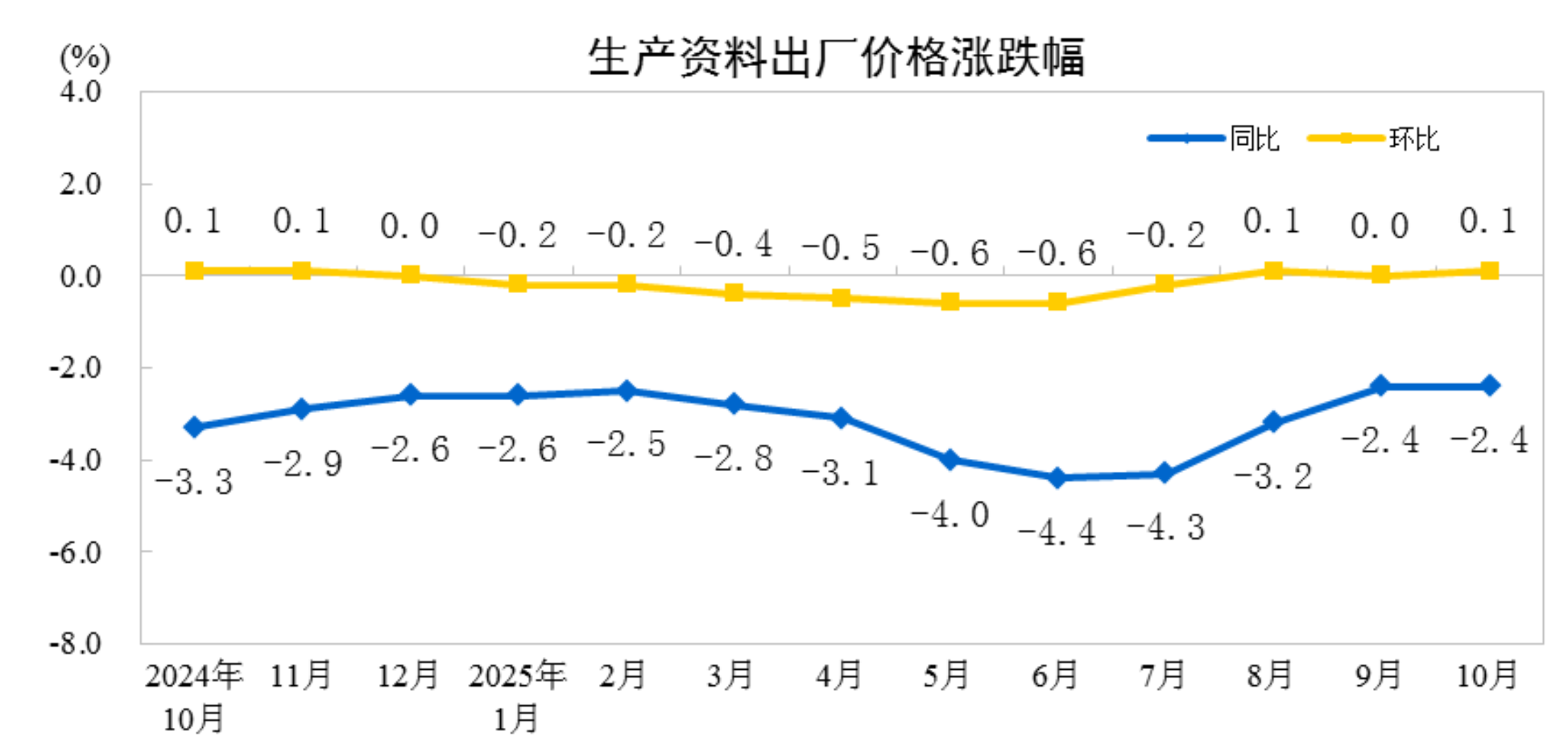
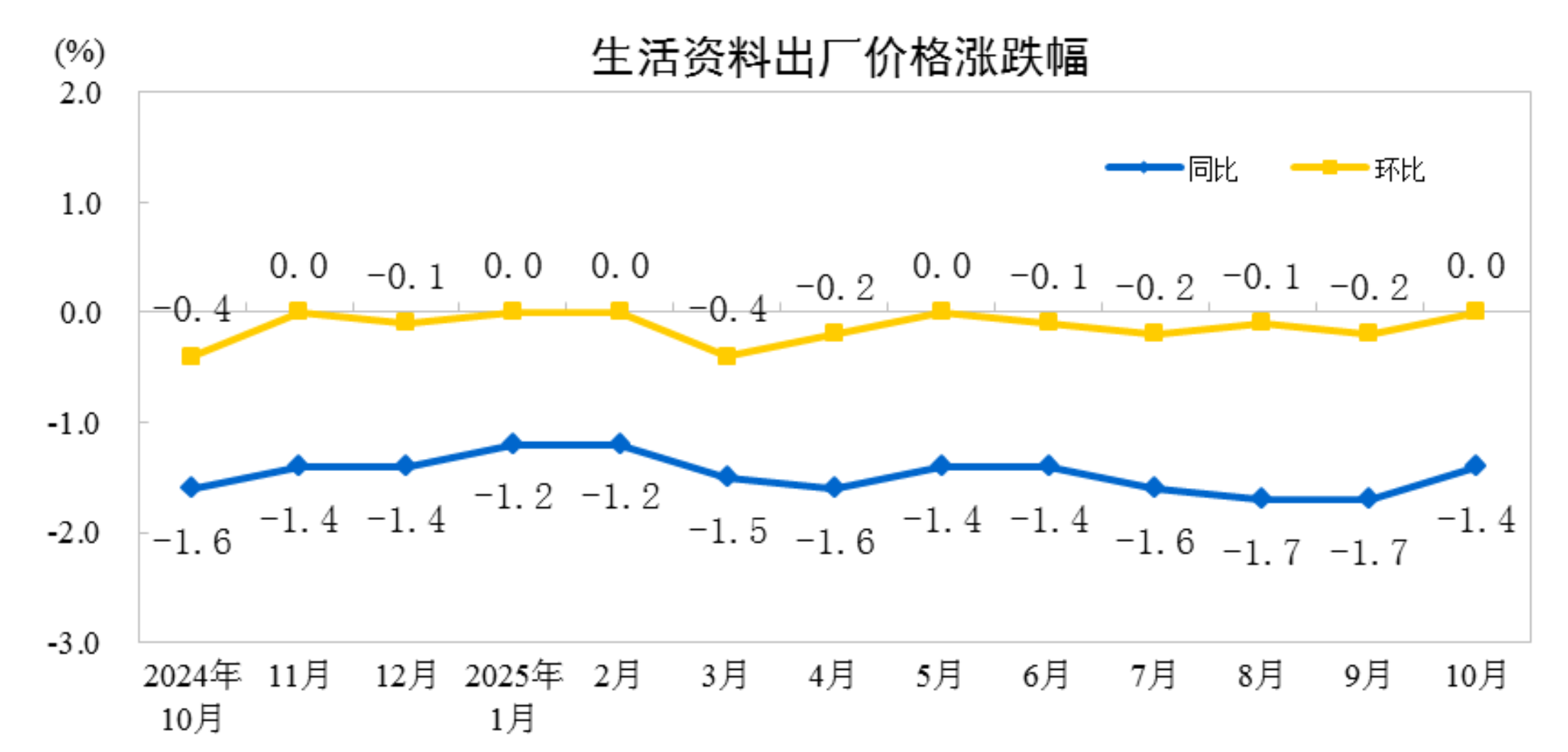
In the purchasing prices of industrial producers, prices of fuel and power decreased by 7.4%, prices of agricultural and sideline products decreased by 5.2%, prices of chemical raw materials decreased by 5.0%, prices of building materials and non-metals decreased by 4.5%, prices of ferrous metals materials decreased by 2.8%, and prices of textile raw materials decreased by 1.8%; prices of non-ferrous metals materials and wires increased by 7.5%.
II. MoM Changes in Industrial Producer Prices
In October, in the ex-factory prices of industrial producers, prices of production materials increased by 0.1%, driving the overall ex-factory price level of industrial producers up by approximately 0.08 percentage points. Among them, prices of mining industry increased by 1.0%, prices of raw material industry remained flat, and prices of processing industry increased by 0.1%. Prices of consumer goods remained flat. Among them, prices of food and clothing both decreased by 0.1%, prices of general daily necessities increased by 0.7%, and prices of durable consumer goods decreased by 0.3%.
In the purchasing prices of industrial producers, prices of non-ferrous metals materials and wires increased by 2.4%, and prices of ferrous metals materials increased by 0.2%; prices of agricultural and sideline products decreased by 1.3%, prices of chemical raw materials decreased by 0.6%, prices of building materials and non-metals and textile raw materials both decreased by 0.2%, and prices of fuel and power decreased by 0.1%.
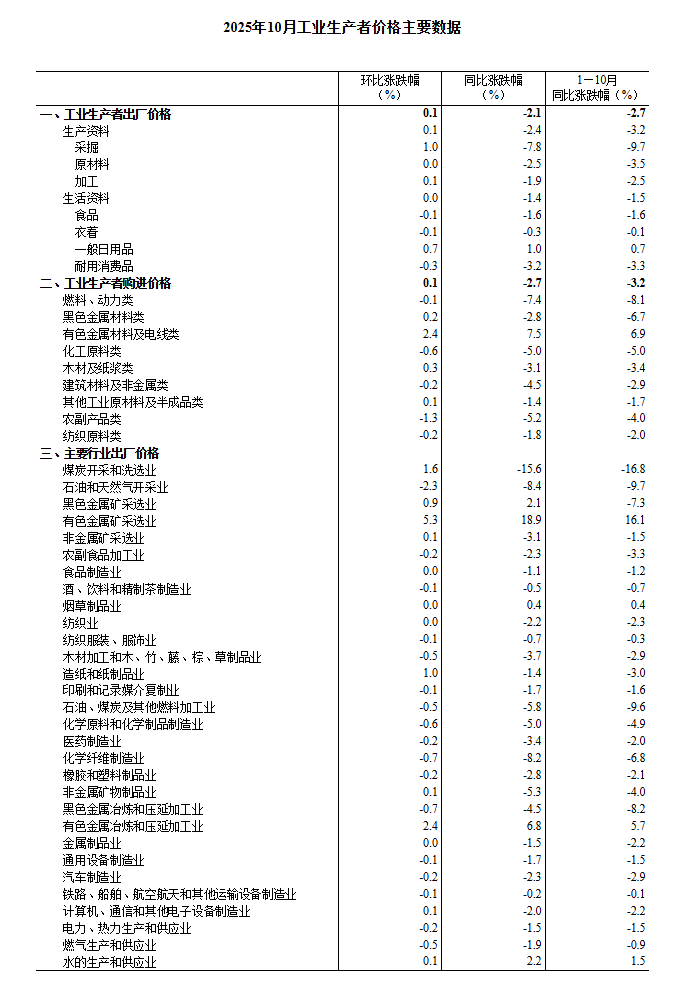
CPI Turned from Decline to Increase in October 2025, PPI Decline Narrowed
—Dong Lijuan, Chief Statistician of the Urban Department of the National Bureau of Statistics (NBS), Interprets CPI and PPI Data for October 2025
In October, as policies and measures such as expanding domestic demand continued to take effect, coupled with the driving effect of the National Day and Mid-Autumn Festival holidays, the consumer price index (CPI) increased by 0.2% MoM and increased by 0.2% YoY. The core CPI, excluding food and energy prices, increased by 1.2% YoY, with the increase expanding for the sixth consecutive month. Influenced by factors such as improved supply-demand relationships in some domestic industries and the transmission of international commodity prices, the industrial producer price index (PPI) turned from flat in the previous month to an increase of 0.1% MoM, marking the first increase of the year; it decreased by 2.1% YoY, with the decline narrowing by 0.2 percentage points from the previous month, narrowing for the third consecutive month.
I. CPI MoM Increase Expanded, Turned from YoY Decline to Increase
CPI increased by 0.2% MoM, with the increase expanding by 0.1 percentage points from the previous month and slightly higher than the seasonal level. Service prices turned from decline to increase. Service prices turned from a decrease of 0.3% in the previous month to an increase of 0.2%, 0.2 percentage points higher than the seasonal level, driving the CPI MoM increase by approximately 0.07 percentage points. Among services, boosted by the overlapping National Day and Mid-Autumn Festival holidays, travel demand was relatively strong, with prices for hotel accommodation, air tickets, and tourism increasing by 8.6%, 4.5%, and 2.5% respectively, all with increases higher than the seasonal level; prices for medical services increased by 0.5%. Food prices rose more than seasonally. Food prices increased by 0.3%, compared with a seasonal average decline of 0.1 percentage points. Among them, holiday consumption demand increased, with prices for fresh vegetables, mutton, fresh fruit, shrimp and crab, and beef rising between 0.5% and 4.3%. Industrial consumer goods prices were stable with some increases. Energy prices fell by 0.4%, while industrial consumer goods prices excluding energy rose by 0.3%, contributing approximately 0.07 percentage points to the MoM increase in CPI. Influenced by rising international gold prices, domestic gold jewelry prices rose by 10.2%.
CPI turned from a 0.3% decline last month to a 0.2% increase YoY. Among these, food and energy prices remained low, but their declines narrowed. Food prices fell by 2.9%, with the decline narrowing by 1.5 percentage points from the previous month, dragging down the CPI by approximately 0.54 percentage points YoY. Within food, prices for pork, eggs, and fresh vegetables fell between 7.3% and 16.0%, with the declines narrowing; prices for beef, mutton, and aquatic products rose between 2.0% and 5.6%, with the increases widening. Energy prices fell by 2.4%, among which gasoline prices dropped by 5.5%, dragging down the CPI by approximately 0.18 percentage points YoY. Core CPI, which excludes food and energy, rose by 1.2% YoY, marking the sixth consecutive month of widening increase and the highest since March 2024. Service prices have been gradually rebounding since March, rising 0.8% this month, with the increase widening by 0.2 percentage points from the previous month. Among these, air ticket prices and hotel accommodation prices rose by 8.9% and 2.8%, respectively; medical service and housekeeping service prices rose by 2.4% and 2.3%, respectively. Industrial consumer goods prices excluding energy rose by 2.0% YoY, marking the sixth consecutive month of widening increase. Among these, gold jewelry and platinum jewelry prices rose by 50.3% and 46.1%, respectively; the effects of policies such as expanding domestic demand continued to show, with prices for household appliances, recreational durable consumer goods, and daily household necessities rising between 2.4% and 5.0%, while the decline in prices for fuel-powered cars narrowed to 2.3%.
II. PPI Turned from Flat to Rising MoM, YoY Decline Continued to Narrow
PPI turned from being flat last month to a 0.1% increase MoM, the first increase this year. The main characteristics of this month's MoM PPI performance were: First, improved supply-demand relationships drove price increases in some industries. Coal mining and washing prices rose 1.6% MoM, coal processing prices rose 0.8%, and PV equipment and component manufacturing prices rose 0.6%, all rising for over two consecutive months. Cement manufacturing, computer manufacturing, lithium-ion battery manufacturing, and integrated circuit manufacturing prices all turned from declines to increases, rising by 1.6%, 0.5%, 0.2%, and 0.2%, respectively. Second, input factors influenced the divergent price trends in domestic non-ferrous metals and oil-related industries. The rise in international non-ferrous metal prices led to a 5.3% MoM increase in the domestic non-ferrous metal ore mining and selection industry, with a 2.4% increase in the non-ferrous metal smelting and rolling processing industry, where gold smelting and copper smelting prices rose by 8.7% and 4.3%, respectively; the decline in international oil prices resulted in a 2.3% decrease in the domestic oil and natural gas extraction industry, and a 0.8% decrease in refined petroleum product manufacturing prices.
The PPI declined 2.1% YoY, with the decline narrowing by 0.2 percentage points from the previous month, marking the third consecutive month of narrowing. First, the ongoing capacity management in key industries led to a narrowing of the YoY price declines. Increased capacity checks and safety supervision, coupled with winter stockpiling and increased electricity demand, narrowed the YoY decline in the coal mining and washing industry by 1.2 percentage points. As market competition order continues to improve and outdated capacity gradually exits, the YoY price declines in PV equipment and components manufacturing, battery manufacturing, and automobile manufacturing narrowed by 1.4, 1.3, and 0.7 percentage points, respectively. Second, the accelerated construction of a modern industrial system and the orderly release of consumption potential drove YoY price increases in related industries. Technological innovation empowered industrial transformation and upgrading, with positive development in the intelligent, green, and integrated development of manufacturing. The non-ferrous metal smelting and rolling processing industry saw a 6.8% YoY price increase, electronic special material manufacturing prices rose by 2.3%, microwave communication equipment prices by 1.8%, ship and related device manufacturing prices by 0.9%, waste resource comprehensive utilization industry prices by 0.7%, and aircraft manufacturing prices by 0.5%. With the continuous implementation and effectiveness of a series of policies to boost consumption, the prices in arts and crafts and ceremonial goods manufacturing increased by 18.4%, sports ball manufacturing by 3.3%, nutritional food manufacturing by 2.1%, and beverage manufacturing by 0.4%.
For queries, please contact Lemon Zhao at lemonzhao@smm.cn
For more information on how to access our research reports, please email service.en@smm.cn